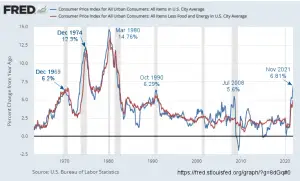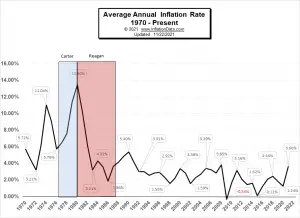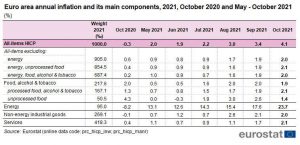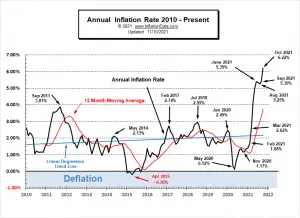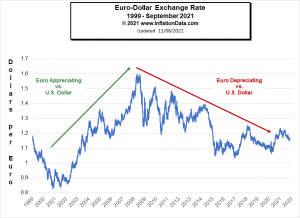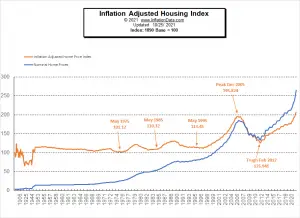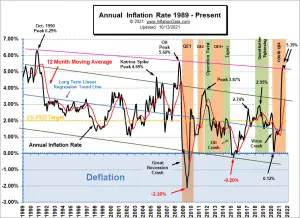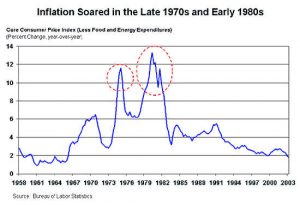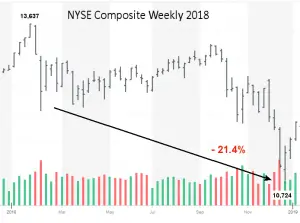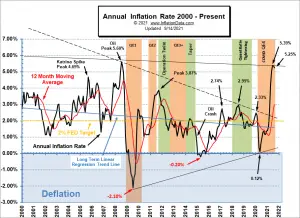The Bureau of Labor Statistics reported that the Annual Inflation Rate rose again in November. Inflation Summary: Annual Inflation highest since May 1982. CPI Index rose from 276.589 to 277.948. Monthly Inflation for November was 0.49% Next release January 12, 2022 Inflation for the 12 months ending in November was Up again from October. October 6.22% -- November 6.81% The earliest millennials were born somewhere between 1980-1985 (depending on which definition of millennial you use), just as we were coming off one of the highest Inflation spikes the U.S. has seen since they began tracking the CPI in 1913. In March of 1980, Inflation topped at 14.76%. By May of 1982, … [Read more...]
How Nixon’s Revolutionary Move Influenced U.S. Inflation For 50 Years
Nixon is not remembered well by history because of the single defining moment of Watergate and the high inflation rate during his Presidency. However, according to a 2017 C-SPAN Presidential Historians Survey, Nixon actually ranked 10th among all presidents for his foreign policy. And the Siena College Research Institute, Presidential Expert Poll of 2010 ranked him 11th on foreign policy accomplishments. Of the 21 different categories, this survey ranked Nixon an average of 27.6th out of 44 presidents... so only slightly worse than average. Nixon’s China Visit One of Nixon’s foreign policy actions was to open diplomatic relations with China. This one action would have long-lasting … [Read more...]
U.S. Inflation is Not the Only One Increasing
It is not just U.S. inflation that is surging. Other countries have followed the U.S. lead and pumped massive liquidity into their economies. For instance, Brazil had double-digit inflation, Mexico had 6.24% inflation, and South Africa had 5% inflation. Brazil: In October Brazil announced that it had broken the double-digit inflation mark at 10.25%. The last time this happened was in 2016. In November they announced that as of October annual inflation was up slightly more to 10.67% with monthly inflation of 1.16%. In addition, Brazil is suffering from 14.1% unemployment resulting in a Misery Index of 24.77%. Currently, the U.S. Misery Index is less than half that at 10.82%. UK Inflation … [Read more...]
Annual Inflation Soars to Highest Level in 31 Years
The Annual Inflation Rate exploded in October, according to the Bureau of Labor Statistics report. Inflation Summary: Annual Inflation highest since October 1990. CPI Index rose from 274.310 to 276.589. Monthly Inflation for October was 0.83% Next release December 10th Inflation for the 12 months ending in October was Up Sharply from September. September 5.39% October 6.22% Current levels have exploded through the pink resistance line. Exceeding the 5.60% Oil Peak of July 2008, and coming very close to the October 1990 peak at 6.29%. If next month takes it up even slightly we will have to go all the way back to 1982 to see higher inflation. BLS … [Read more...]
How Foreign Currencies Act as an Inflation Hedge
One method investors can use to hedge against inflation is investing in a variety of foreign currencies. The key of course is which currencies you choose as an inflation hedge. You need to invest in those countries' currencies, which will provide you with better protection from exchange rate changes to be successful at hedging against inflation. Inflation in the United States has been relatively tame since the 1980s but it is currently at risk due to massive money creation by the FED via Quantitative Easing. However, inflation risk can be mitigated with the help of investment diversification. One method investors who are looking to protect their money against inflation would use is to … [Read more...]
Do Housing Prices Always Go Up?
In the last few years, housing prices have skyrocketed, and investors are once again jumping on the housing bandwagon as an excellent way to make money. The same sentiment existed in the early 2000s as housing prices were rising rapidly then as well. These periods both created the impression that “housing prices always go up”. But is that actually true? If we look at the “nominal” prices of houses, i.e., the cost in dollars BEFORE adjusting for inflation, it does appear that housing prices go up fairly consistently. In the following chart, we see housing prices since 1890. The blue line is the nominal housing price, and we can see a very gradual increase up through the early 1970s. Prices … [Read more...]
September Inflation Rebounds
The Annual Inflation Rate rebounded in September, according to the Bureau of Labor Statistics report. Inflation Summary: Annual inflation was 5.39% in September, 5.25% in August, 5.37% in July, and 5.39% in June. CPI Index rose from 273.567 in August to 274.310 in September. Monthly Inflation for September was 0.27%, August was 0.21%, and July was 0.48%. Next release November 10th Inflation for the 12 months ending in September was Up from August. Since the BLS rounds to 1 decimal place, they reported June and July as 5.4% and August as 5.3%. So September is once again at June levels. The last time inflation was this high was the 5.60% of July 2008. Before that, we … [Read more...]
Why is a Little Bit of Inflation Considered Good for the Economy?
The short answer is because the U.S. Federal Reserve Board, i.e., the “FED,” says it is. The longer answer is much more complicated. To determine whether 2% is really best for you, we will have to look at a variety of different factors. First of all, it might surprise you to know that it wasn’t always that way. It wasn’t until January 25th, 2012, that U.S. Federal Reserve Chairman Ben Bernanke set a 2% target inflation rate. Before that, the FED didn’t have a specific inflation target but instead regularly set a target range. This range was often between 1.7% and 2%. But even that range is relatively new, and some economists still believe that Zero percent inflation is optimal. Prior … [Read more...]
FED Issues September 2021 Statement
On September 22, 2021, the Federal Reserve reported its current policy position. Currently, the FED is creating liquidity (i.e., printing money) through its Quantitative Easing (QE) program at the rate of $120 billion per month. The market has been fearing that the FED would begin tapering, i.e., cutting back on its liquidity creation. Rumor was that the FED would start reducing their QE by $10-$15 billion per month due to inflation concerns. The last time the FED embarked on a tapering plan back in 2017, they used a two-prong approach of raising the FED Funds rate and reducing the monthly printing by $10 Billion every three months (i.e., roughly $3.3 billion per month). The result of … [Read more...]
August 2021 Inflation Down Slightly
On September 14th, 2021, the Bureau of Labor Statistics said that in August 2021, the Annual Inflation Rate was down. Inflation Summary: Annual Inflation was 5.25% in August, 5.37% in July, and 5.39% in June. CPI Index rose from 273.003 in July to 273.567 in August. Monthly Inflation for July was 0.48% and 0.21% for August. Next release October 13th Inflation for the 12 months ending in August was down 0.12% from July. Since the BLS rounds to 1 decimal place, they reported June and July as 5.4% and August as 5.3%. The last time inflation was this high was the 5.6% of July 2008. Prior to that, we have to go all the way back to the 6.29% of October 1990 to find a higher … [Read more...]

